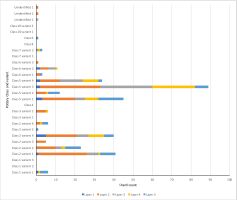

A notable feature of the ceramic assemblage from Trench D is the disparity between the quantities of potsherds in different layers (Table 13; Figure 40). Layer 2 contained a far greater quantity of potsherds than any of the others. This may indicate a difference in the nature of the activities that took place in that part of the site during a particular time (perhaps a period of more intense occupation, or alternatively a period of dumping or episode of backfilling). Equally, however, it may also reflect a different process of ceramic recovery and retention during excavation. Here, we continue to work on the premise that similar retention strategies were used across the site.
| Class/variants | Layer 1 | Layer 2 | Layer 3 | Layer 4 | Layer 5 | Total |
|---|---|---|---|---|---|---|
| Class 1 variant 1 | 1 | 1 | 4 | 6 | ||
| Class 1 variant 2 | ||||||
| Class 1 variant 3 | ||||||
| Class 2 variant 1 | 1 | 25 | 6 | 1 | 8 | 41 |
| Class 2 variant 2 | 10 | 3 | 2 | 8 | 23 | |
| Class 2 variant 3 | 5 | 5 | ||||
| Class 2 variant 4 | 5 | 16 | 6 | 8 | 5 | 40 |
| Class 2 variant 5 | 1 | 1 | ||||
| Class 2 variant 6 | 2 | 1 | 3 | 6 | ||
| Class 3 variant 1 | ||||||
| Class 3 variant 2 | 5 | 1 | 6 | |||
| Class 4 | ||||||
| Class 5 variant 1 | 3 | 17 | 5 | 7 | 13 | 45 |
| Class 5 variant 2 | 5 | 1 | 6 | 12 | ||
| Class 5 variant 3 | 2 | 31 | 27 | 22 | 7 | 89 |
| Class 5 variant 4 | 2 | 10 | 12 | 8 | 2 | 34 |
| Class 6 variant 1 | 2 | 1 | 3 | |||
| Class 6 variant 2 | 2 | 4 | 4 | 1 | 11 | |
| Class 6 variant 3 | 1 | 1 | ||||
| Class 7 variant 1 | ||||||
| Class 7 variant 2 | 1 | 1 | 1 | 3 | ||
| Class 8 | ||||||
| Class 9 | 1 | 1 | ||||
| Class 10 variant 1 | ||||||
| Class 10 variant 2 | ||||||
| Unidentified 2 | 1 | 1 | ||||
| Unidentified 2 | 1 | 1 | ||||
| Unidentified 1 | 1 | 1 | ||||
| Total | 16 | 135 | 64 | 54 | 60 | 330 |
Despite differences in the relative quantity of ceramic remains between layers in Trench D, we notice the same distribution of classes and variants in layers 1 to 4. Classes 1, 4, 7, 9 and 10 are almost absent from the assemblage. Class 2 is present along with Class 5 variant 1, but they are less frequent than those of Class 5 variants 3 and 4, which are clearly the predominant wares. Class 6 is also represented but accounts for a much smaller proportion of the overall assemblage. Another characteristic is the presence of glazed wares (Unidentified types). In layer 5 we can identify a change in this distribution. Here, we see an increase in the proportion of Class 2 and Class 5 variant 1, while the relative proportion of Class 5 variants 3 and 4 decreases.
On the basis of this analysis, we can assign layers 2 to 5 to the second phase of occupation identified in Trenches C and F, dating to the 7th and 8th centuries CE. Layer 1 can be dated to the third phase of occupation, which dates from the 10th century CE onwards (Table 14).
| Layer | Date range |
|---|---|
| 1 | Post 10th century |
| 2 | 7th to 8th century |
| 3 | 7th to 8th century |
| 4 | 7th to 8th century |
| 5 | 7th to 8th century |
Internet Archaeology is an open access journal based in the Department of Archaeology, University of York. Except where otherwise noted, content from this work may be used under the terms of the Creative Commons Attribution 3.0 (CC BY) Unported licence, which permits unrestricted use, distribution, and reproduction in any medium, provided that attribution to the author(s), the title of the work, the Internet Archaeology journal and the relevant URL/DOI are given.
Terms and Conditions | Legal Statements | Privacy Policy | Cookies Policy | Citing Internet Archaeology
Internet Archaeology content is preserved for the long term with the Archaeology Data Service. Help sustain and support open access publication by donating to our Open Access Archaeology Fund.